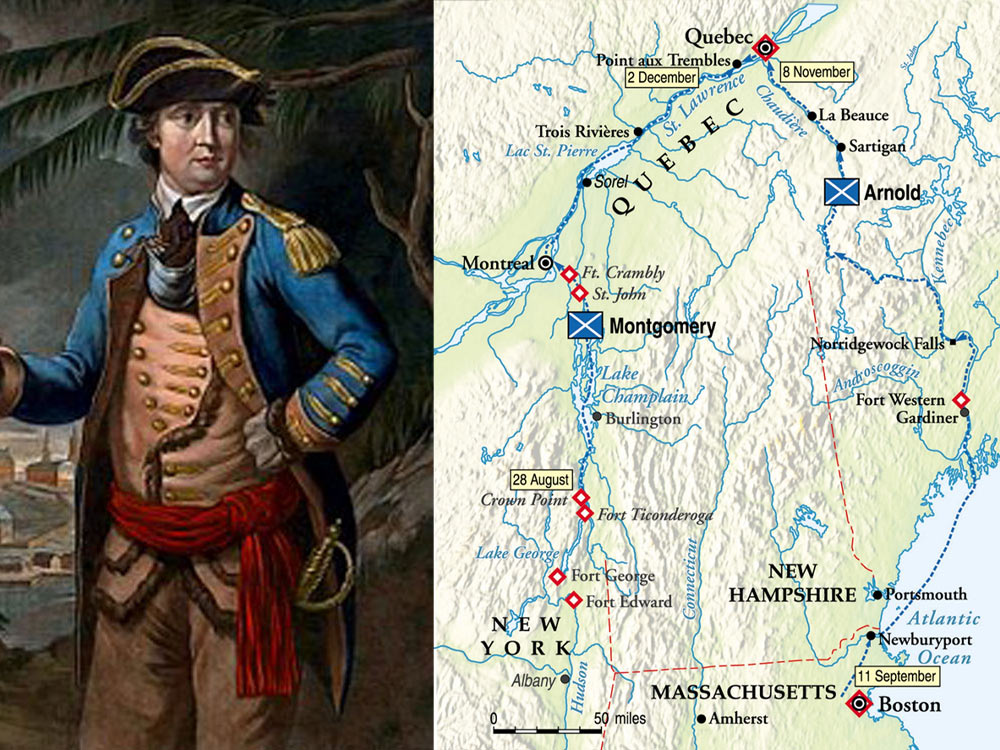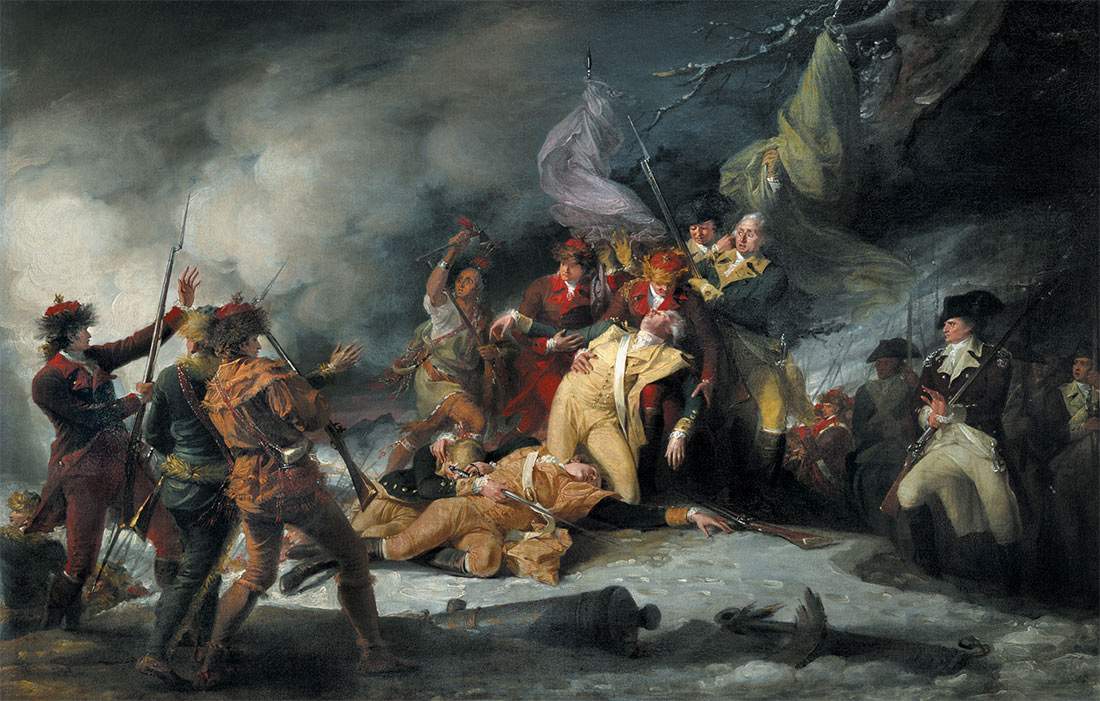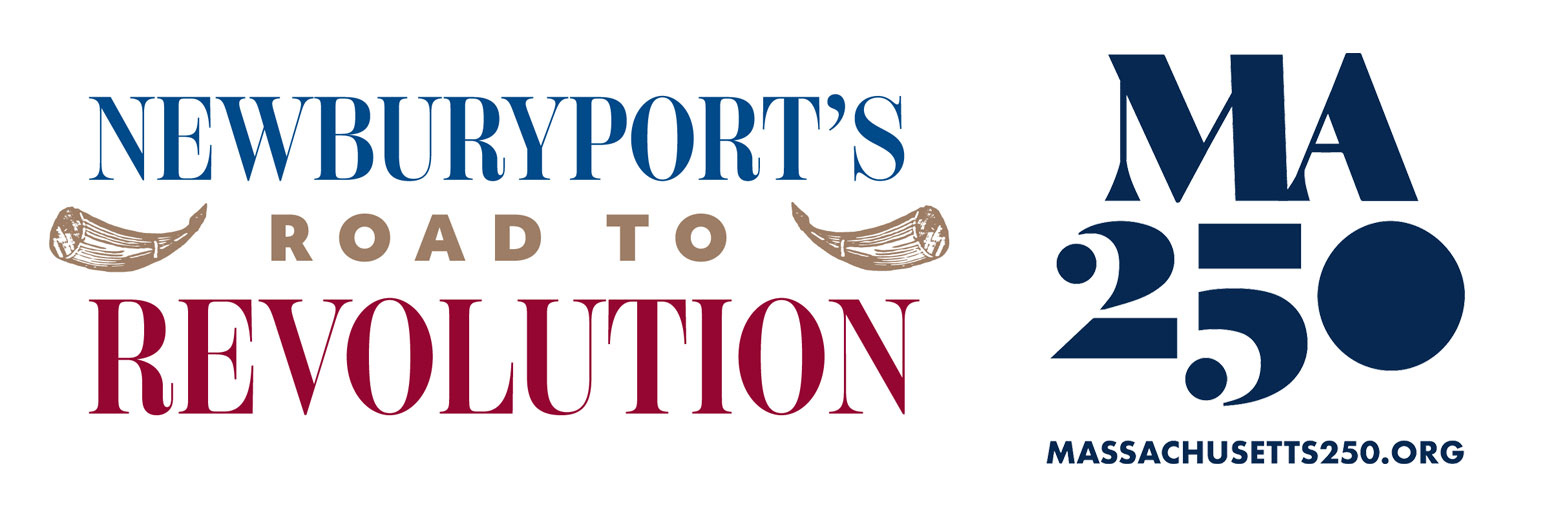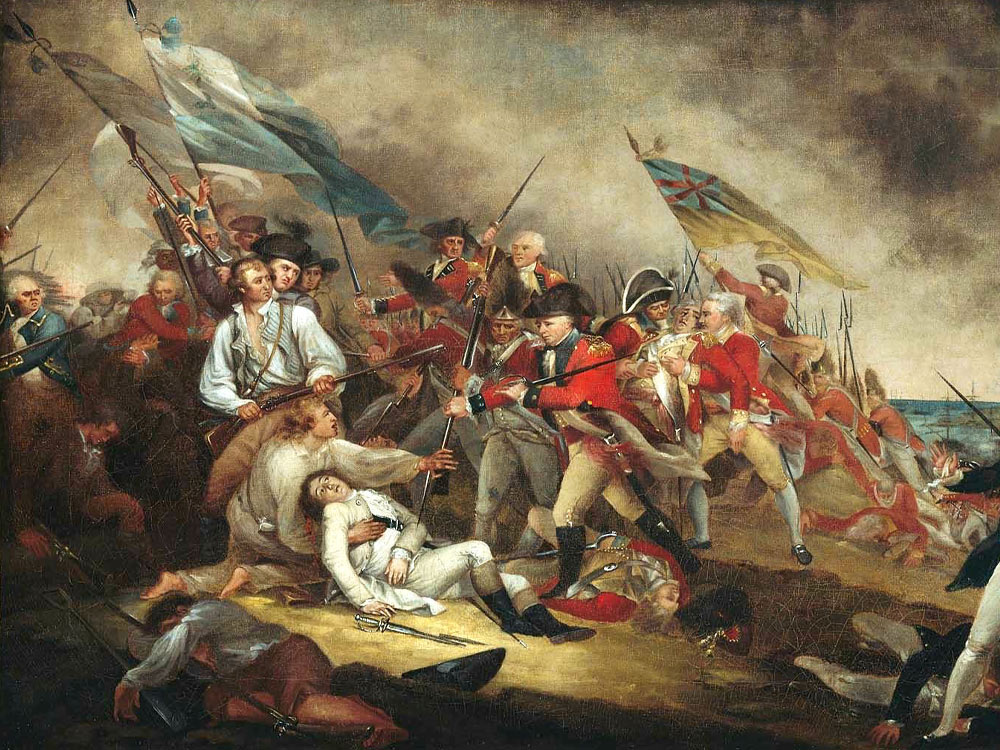As early as August 1775, Washington launched one of the most daring undertakings of the war. An expeditionary force, led by Colonel Benedict Arnold, would set out to capture Quebec City and thus, hopefully force Britain out of Canada. General Wolfe succeeded in attacking Quebec 16 years earlier, but then he had control of the sea. Now, with the Royal Navy firmly in command of all sea routes, a repeat of that plan was off the table. The maintain the element of surprise, Arnold decided on a harrowing trek through the treacherous wilderness of Maine.
Only a few months previously, in May 1775, Arnold and Ethan Allen captured Fort Ticonderoga in upper New York state. With control of this key post on Lake Champlain, American forces held a gateway into British Canada. Arnold, familiar with the region from prior business dealings, believed that French-speaking Canadiens might by sympathetic to the American cause. Intelligence also suggested that British forces in Quebec were sparse—no more than 600 regular troops guarded the entire province.
Arnold proposed a two-prong plan to Washington: complementing a more conventional advance from Fort Ticonderoga north by General Richard Montgomery, Arnold would lead a second, simultaneous thrust into Canada via Maine. Arnold’s route would lead 1,100 troops from Cambridge to Newburyport and then by ship to the mouth of the Kennebec River. From there, he would march through the vast and poorly charted wilderness to Quebec. Arnold had calculated 180 miles and 20 days of travel. Three hundred and fifty miles and 64 days later his exhausted and depleted force arrived at the gates of Quebec City.

Benedict Arnold in Newburyport
Nathaniel Tracy received orders from Washington to provide the transport for the expedition from Newburyport to Maine. Ironically this was then considered one of the more dangerous parts of the plan because of British Navy successes in interdiction. Tracy was promised reimbursement for his expenses, but it’s more likely, based on a November 1775 letter, that he was never paid.
Head Quarters [Cambridge] Sept 2. 1775
You are hereby authorized & impowered to take up for the Service of the sd Colonies so many Vessels as shall be necessary for the transporting a Body of Troops to be detached from this Army on a secret Expedition: Freight of such Vessels to be paid in such a Manner and at such a Rate as is indorsed hereon: And in Case of Loss or Damage to such Vessels or any of them such Loss or Damage to be compensated by the Publick according to an Estimation to be made before the Vessels proceed in the above Service.
— George Washington
Washington and Arnold were uncertain of Native support for, or opposition to, the effort. On August 30, Washington wrote to General Schuyler of a meeting he had held with an Abenaki chief, “The chief says the Indians of Canada in general, and also the French, are greatly in our favor, and determined not to act against us.” Four Abenakis accompanied the expedition as scouts and guides.
Camp at Cambridge, Sept 14, 1775
To Colonel Benedict Arnold
Sir: – You are entrusted with a command of the utmost consequence to the interests and liberties of America. Upon your conduct and courage, and that of the officers and soldiers detached on this expedition, not only the success of the present enterprise, …but the safety and welfare of the whole continent may depend. I charge you, therefore, and the officers and soldiers under your command, … that you consider yourselves as marching not through the country of an enemy, but of our friends and brethren, for such the inhabitants of Canada, and the Indian nations, have approved themselves in this unhappy contest between Great Britain and America, and that you check, by every motive of duty and fear of punishment, every attempt to plunder or insult the inhabitants of Canada…
…. I also give it in charge to you to avoid all disrespect of the religion of the country, and its ceremonies. Prudence, policy, and a true Christian spirit, will lead us to look with compassion upon their errors without insulting them. While we are contending for our own liberty, we should be very cautious not to violate the rights of conscience in others, ever considering that God alone is the judge of the hearts of men, and to him only in this case, they are answerable…. Thus wishing you, and the officers and soldiers under your command, all honor, safety, and success, I remain, Sir,
Your most obedient humble servant,
— George Washington
While in Newburyport, General Arnold dined with Nathaniel Tracy and Tristram Dalton… “whose mansions were well accustomed to the presence of distinguished guests”. Arnold’s detachment gained an addition to its numbers with the Rev. Samuel Spring (afterwards pastor of the Third Religious Society in Newburyport) accompanying the expedition in the capacity of chaplain. He had previously served at the Battle of Bunker Hill.
Arnold’s force sailed from Newburyport aboard eleven vessels on Sept 19, then up the Kennebec River and landing at Fort Western (Augusta) three days later. But from that point on, and relying on an inaccurate map of the interior, the journey was plagued by hardship. The soldiers, now using flat-bottomed boats called bateaux, struggled with treacherous currents and had to haul boats over land from one river to another. Many boats leaked, spoiling vital food supplies and gunpowder. Inexperience navigating whitewater rapids led to further losses. As the men pushed deeper into the wilds of Maine, they encountered swamps, steep terrain, and freezing weather and the conditions increasingly desperate. Demoralization, hunger and sickness set in. More than a third of the original force turned back before reaching the halfway point.
Despite these setbacks, Arnold and about 600 starving and exhausted men, with the help of sympathetic Canadiens, crossed the Saint Lawrence River on November 13 and 14. Although Arnold’s arrival was a surprise, his ability to capture the city lacked the manpower, gunpowder and artillery required. He withdrew along the river to await General Montgomery, whose force were advancing from the south. Upon arrival, the combined American force launched an attack on the city on December 31, 1775. The assault failed, Montgomery was killed, and Arnold badly wounded in the leg. The Americans ultimately retreated in May 1776, dashing their hopes of bringing Canada into the Revolution.

The Death of General Montgomery in the Attack on Quebec, December 31, 1775 by John Trumbull, Yale University Gallery, 1786
Pictured is Oneida leader Atayataghlonghta, aka Colonel Louis Joseph Cook, the highest ranking officer of Native or African descent in the Continental Army and who aided in the Quebec Expedition.
Benedict Arnold, for his leadership and bravery, was promoted to Brigadier General. Today, the route he took is commemorated as the Arnold Trail to Quebec and is listed on the National Register of Historic Places.
Benedict Arnold – Traitor
Arnold’s career marked by brilliance in battle and deep resentment over perceived slights and lack of recognition, turned very dark. This hero of the Revolution, wounded twice in battles, and promoted to Brigadier General, obtained command of West Point in 1780. West Point was a strategically important fortification 60 miles up the Hudson River from New York. Long premediated, Arnold plotted to surrender it to the British for $20,000 ($3 million today). If he had been successful, the capture by the British would have rivaled the strategic impact of capturing Quebec 5 years earlier. Historian Joshua Coffin details the following from the diary of local soldier Joshua Davis:
“September. This month, the most flagrant instance of treachery that occurred during the revolutionary war, was discovered, by the apprehension of Major Andre, a British officer, who was executed as a spy. October second. The treachery was, an attempt, by general Arnold, to deliver up West Point to the enemy. From a journal kept by a Newbury soldier, I extract the following. ‘September twenty-fourth. …This day about one o’clock general Washington, General Knox, Marquis La Fayette came to West Point to take a view of the fort…This night Arnold’s plot was discovered. He had news of the British officer being taken. He told his wife he was a dead man. He took his horse and rode to the ferry as soon as he could to his barge, when he made the best of his way to a British ship.”
And this intriguing extract from History of Newburyport by Euphemia Vale places Newburyports at the scene of the crime:
“…in the barge which conveyed him (Arnold) to the British ship ” Vulture,” were two members of Capt. Richard Titcomb’s company …Samuel Pillsbury and John Brown …who were, at the time of Arnold’s escape, on duty at the barge. After having reached the deck of the “Vulture,” … the arch-traitor turned to the bargemen, and said, ” My lads, I have quitted the rebel army, and joined the standard of his Britannic Majesty ; if you will join me, I will make Sergeants and Corporals of you all.” But his infamous offer had no influence on the honest patriots in the barge. That neither one of Capt. Titcomb’s men was seduced by his offers, is proved.”

Special Thanks to:


Plan Your Visit
Plan Your Visit
- Museum Hours
Sunday: 12 pm - 5 pm
Closed Monday
- Tickets
Free for NBPT residents, kids under 12, and museum members
Cost of admission includes access to the Discovery Center.
- Parking
City parking is available adjacent to the museum. View parking lot directions.

